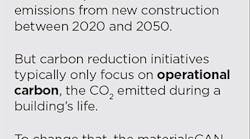The building industry has made strides in reducing emissions from operational carbon, the carbon dioxide emitted during a building’s life. But until now, there were few solutions for addressing embodied carbon – the carbon dioxide that’s emitted during the extraction, manufacturing and transport of building materials and product ingredients.
“We’re providing education and awareness around what embodied carbon is and ways that people can address the carbon footprint of the spaces they design,” explains Lisa Conway, vice president of sustainability for Interface.
Why Embodied Carbon is Important
The building and construction industry is the world’s largest emitter of greenhouse gases, according to a report by the Intergovernmental Panel on Climate Change (IPCC), which also called for every sector to decarbonize by 2050. The volume of greenhouse gas emissions – some 30-40 percent of the global total – requires equally large-scale action by the industry.
[Related: Tips to Move Your Building Toward Net Zero]
However, much of the focus has remained on operational carbon rather than embodied carbon, even though the embodied form will make up about half of all carbon emissions from new construction between 2020 and 2050.
“Having interiors be carbon-storing means our spaces are actually part of the solution to global warming instead of just measuring how much less of a problem they are. That’s the goal, and we’re going to start somewhere really meaningful soon.” - Lisa Conway
Interiors in particular are often forgotten during this discussion because the little conversation that does exist around embodied carbon tends to focus on structural products like concrete and steel.
“No one is talking about the impact of materials that go into interiors,” Conway says. “Once you’re inside the building or just doing a fit-out project, the impact inside is soaring. You could be specifying the highest carbon impact material and not even know it.”
Tools for Reducing Embodied Carbon
It’s currently possible to estimate some portion of a product’s carbon footprint, Conway explains. Environmental Product Declarations (EPDs) include Global Warming Potential (GWP) among a long list of other information. However, EPDs can be long and difficult to navigate.
Want to do your part?
Here’s what you can do to combat climate change.
“Many people don’t know what GWP means, and it doesn’t exist in a lot of what people use to choose materials, which are product labels. None of that has a transparent carbon footprint aspect,” says Conway. “Then to further complicate it, EPDs could have different background product category rules or data assumptions, so unless you’re a real expert, it’s hard to compare EPD to EPD.”
A new tool by Microsoft and materialsCAN member Skanska will attempt to scale this hurdle. Currently in early beta testing, the free Embodied Carbon Calculator for Construction (EC3) will pull in data from EPDs, display the variance between EPDs that have different product category rules and help users search for low-carbon-footprint alternatives.
Sign up to help test the EC3 tool or to offer a pilot project as a case study.
After EC3 launches in fall 2019, the team plans to extend its membership to cover more product types than the founding members represent and to advocate for carbon-storing interiors, the logical next step after carbon-neutral products.
Carbon-storing interiors are created from bioplastics derived from plants, which naturally store carbon dioxide during photosynthesis. If the bioplastic products can be recycled repeatedly, the carbon absorbed by the plant stays in the product instead of being released by biodegrading.
[5 Air Purifying Indoor Plants]
“Having interiors be carbon-storing means our spaces are actually part of the solution to global warming instead of just measuring how much less of a problem they are,” Conway says. “That’s the goal, and we’re going to start somewhere really meaningful soon.”
Two handpicked articles to read next:



